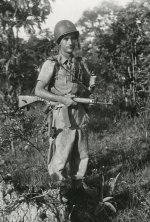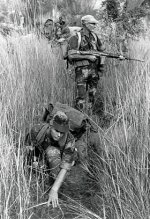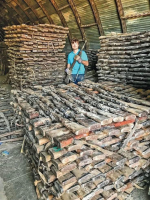You are using an out of date browser. It may not display this or other websites correctly.
You should upgrade or use an alternative browser.
You should upgrade or use an alternative browser.
Picture of the day
- Thread starter jwhc
- Start date
Dark Alley Dan
CGN Ultra frequent flyer
- Location
- Darkest Edmonton
The first few years after WW2 would have been an interesting time to be in the military. All kinds of loopy used sh!t floating around.
Cottage Hill Bill
CGN Regular
- Location
- Pensacola, FL USA
France fielded a large number of ex-SS troops in Indochina immediately after the war.
bdft
CGN Ultra frequent flyer
Read Devil’s Guard by George Robert Elford (published 1971). It depicts a German SS officer's escape from Germany and his adventures in Indochina in the French Foreign Legion. The accuracy is suspect so take it with a grain of salt.France fielded a large number of ex-SS troops in Indochina immediately after the war.
Dark Alley Dan
CGN Ultra frequent flyer
- Location
- Darkest Edmonton
I had a canoeing coach in college who grew up in Algeria after the war. He recalled walking past the barracks and hearing all the old hits - Horst Wessel, Panzerlied, Panzers into Africa...
fat tony
CGN Ultra frequent flyer
This French Marine chap apparently has an FS knife in his pocket. The lozenge shaped guard - could be a 'nail head dagger' or 'le commando inox?' The low def pic makes it tough to discern. Looks like a plain old third pattern though, esp. Since the handle is leaning over so much.France fielded a large number of ex-SS troops in Indochina immediately after the war.
The caption reads, in part;
Among the weapons occasionally seen in their hands was the T223 rifle—a rare, American-produced variant of the German Heckler & Koch HK33. Chambered in 5.56mm and built with a roller-delayed blowback system, the T223 offered Special Forces troops a dependable alternative to the standard-issue M16, which was still shaking off early reliability issues.
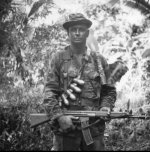
Among the weapons occasionally seen in their hands was the T223 rifle—a rare, American-produced variant of the German Heckler & Koch HK33. Chambered in 5.56mm and built with a roller-delayed blowback system, the T223 offered Special Forces troops a dependable alternative to the standard-issue M16, which was still shaking off early reliability issues.

Some of that stuff is still "floating around" depending on where you live. In some locations it's still being issued.The first few years after WW2 would have been an interesting time to be in the military. All kinds of loopy used sh!t floating around.
If I had been in French service in Indochina in the 40’s or 50’s I’d way rather have an mp44 than, say, any French service arm of the period, or any American one, for that matter.
It would be like having an AK while the viet minh still had mosin carbines.
It would be like having an AK while the viet minh still had mosin carbines.
fat tony
CGN Ultra frequent flyer
Occupied nation - services suddenly required by the Allies!
https://www.belgiumwwii.be/belgique-en-guerre.html
This website is in Flemish, French, and German. Youhave to download a translator app to get any use of it unless you are fluent in any of these three languages/dialects.
Looks like rare info in terms of Belgians.

Members of one of the Belgian Fusilier Battalions parading in Northern Ireland, where they took 20 weeks of basic military training, Late 1944 - early 1945. They were only lightly armed and had minimal equipment. The locals fought against the Belgian recruits.
Northern Ireland was the only secure location in the UK which had capacity for temporary occupancy for military training. I think the locals begged to differ.
Seriously there was not enough time for anything else. I imagine screening was a key Allied priority. Some of the units served during the last Allied campaigns in Europe.
https://www.belgiumwwii.be/belgique-en-guerre.html
This website is in Flemish, French, and German. Youhave to download a translator app to get any use of it unless you are fluent in any of these three languages/dialects.
Looks like rare info in terms of Belgians.

Members of one of the Belgian Fusilier Battalions parading in Northern Ireland, where they took 20 weeks of basic military training, Late 1944 - early 1945. They were only lightly armed and had minimal equipment. The locals fought against the Belgian recruits.
Northern Ireland was the only secure location in the UK which had capacity for temporary occupancy for military training. I think the locals begged to differ.
Seriously there was not enough time for anything else. I imagine screening was a key Allied priority. Some of the units served during the last Allied campaigns in Europe.
Last edited:
Great post here about the little-known British Resistance Organisation (Auxiliaries/Stay-behinds) and how so many went on to be recruited into the wartime SAS, as the threat of an invasion by Nazi Germany receded ... We know some Auxiliaries went on to join the SAS. With thanks to Nick Thomas we have this photo of 1 SAS in Auxerre in 1944 in France on Operation Douglas. Cronk was in the West Norfolk Auxiliary Units Scout Section. In normal life he was an ice cream salesman. He served in Operation Kipling
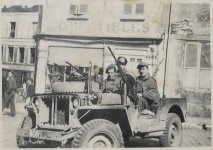

Phuoc Tuy Province, South Vietnam. July 1970. Armed with a US Rocket Launcher 66mm M72 Light Anti Tank Weapon (LAW) and an L1A1 self-loading rifle, Private Nicholas Andropof of Reservoir, Victoria, patrols silently through a rubber plantation during a combined infantry-tank operation against Viet Cong bunker systems in Operation Petrie. He is a member of 8th Battalion, The Royal Australian Regiment
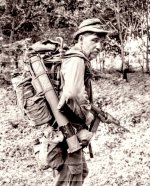

The Mas 49 semi auto rifle and Mat49 submachine gun, were both excellent firearms in the field.If I had been in French service in Indochina in the 40’s or 50’s I’d way rather have an mp44 than, say, any French service arm of the period, or any American one, for that matter.
It would be like having an AK while the viet minh still had mosin carbines.
I can attest to the versatility of the Mat49, from personal experience.
fat tony
CGN Ultra frequent flyer
Forgotten scandal of WWII Britain
So what happened to them?
Some say they were dumped into Beaufort's Dyke. The next question: when will the marine dump pile go up?
So what happened to them?
Some say they were dumped into Beaufort's Dyke. The next question: when will the marine dump pile go up?
Last edited:















































